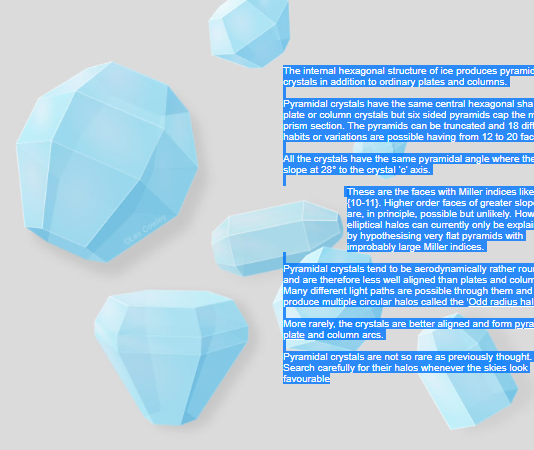Pyramidal Crystals
Pyramidal Crystals: A Closer Look at the Hexagonal Structure of Ice
Atmospheric optics never ceases to amaze us with its captivating phenomena. Among the wonders it offers are pyramidal crystals, which possess a unique internal hexagonal structure. These crystals, along with the more commonly observed plate and column crystals, contribute to the breathtaking display of atmospheric halos.
Pyramidal crystals share the same central hexagonal shape as plate or column crystals, but they have an intriguing twist. The middle prism section of these crystals is capped by six-sided pyramids, resulting in a distinctive appearance. Depending on the truncation of the pyramids, pyramidal crystals can exhibit a range of habits or variations, with anywhere from 12 to 20 faces.
A key characteristic of pyramidal crystals is their consistent pyramidal angle. The faces of these crystals slope at an angle of 28° to the crystal's 'c' axis. This specific orientation allows for the formation of unique halo features associated with pyramidal crystals.
The faces of pyramidal crystals are identified using Miller indices, such as {10-11}. While higher order faces with greater slope are theoretically possible, they are considered unlikely. Interestingly, the presence of elliptical halos suggests the existence of very flat pyramids with unusually large Miller indices.
Due to their aerodynamic shape, pyramidal crystals tend to be more rounded than plates and columns. This rounded form leads to less alignment of the crystals in the atmosphere, resulting in a greater variety of light paths passing through them. Consequently, multiple circular halos, known as 'Odd radius halos,' can be observed when light interacts with these crystals.
Although less common, there are instances when pyramidal crystals align more precisely, forming pyramidal plate and column arcs. These arcs add another layer of beauty and complexity to the atmospheric display, providing a captivating sight for those fortunate enough to witness them.
Contrary to previous assumptions, pyramidal crystals are not as rare as once believed. When the conditions are favorable and the skies are clear, it is worth paying close attention to the sky for the presence of pyramidal crystal halos. Their unique characteristics and striking appearance make them a fascinating subject of study and observation.
In conclusion, pyramidal crystals are a captivating component of atmospheric optics, showcasing the incredible variety and beauty found in nature. Their hexagonal structure, capped by six-sided pyramids, sets them apart from other crystal formations. With their aerodynamic shape and potential for varied light paths, pyramidal crystals produce mesmerizing halo phenomena, including the intriguing 'Odd radius halos.' So, the next time you gaze up at the sky, take a moment to appreciate the wonder of pyramidal crystals and the awe-inspiring displays they contribute to in our atmosphere.

The internal hexagonal structure of ice produces pyramidal crystals in addition to ordinary plates and columns.
Pyramidal crystals have the same central hexagonal shape as plate or column crystals but six sided pyramids cap the middle prism section. The pyramids can be truncated and 18 different habits or variations are possible having from 12 to 20 faces.
All the crystals have the same pyramidal angle where the faces slope at 28° to the crystal ‘c’ axis.
These are the faces with Miller indices like
{10-11}. Higher order faces of greater slope are, in principle, possible but unlikely. However, elliptical halos can currently only be explained by hypothesising very flat pyramids with improbably large Miller indices.
Pyramidal crystals tend to be aerodynamically rather rounded and are therefore less well aligned than plates and columns. Many different light paths are possible through them and produce multiple circular halos called the 'Odd radius halos'.
More rarely, the crystals are better aligned and form pyramidal plate and column arcs.
Pyramidal crystals are not so rare as previously thought. Search carefully for their halos whenever the skies look favourable
Note: this article has been automatically converted from the old site and may not appear as intended. You can find the original article here.
Reference Atmospheric Optics
If you use any of the definitions, information, or data presented on Atmospheric Optics, please copy the link or reference below to properly credit us as the reference source. Thank you!
-
<a href="https://atoptics.co.uk/blog/pyramidal-crystals/">Pyramidal Crystals</a>
-
"Pyramidal Crystals". Atmospheric Optics. Accessed on April 20, 2024. https://atoptics.co.uk/blog/pyramidal-crystals/.
-
"Pyramidal Crystals". Atmospheric Optics, https://atoptics.co.uk/blog/pyramidal-crystals/. Accessed 20 April, 2024
-
Pyramidal Crystals. Atmospheric Optics. Retrieved from https://atoptics.co.uk/blog/pyramidal-crystals/.